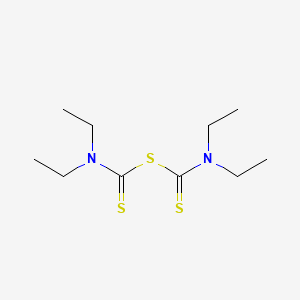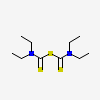Sulfiram
- SULFIRAM
- Monosulfiram
- Sulfirame
- 95-05-6
- Tetmosol
- Create:2005-03-26
- Modify:2025-01-18

- monosulfiram
- sulfiram
- tetraethylthiuram monosulfide
- SULFIRAM
- Monosulfiram
- Sulfirame
- 95-05-6
- Tetmosol
- Sulfiramum
- Tetrucid
- Sanigal
- Tetmos
- Kutka
- Sarcocide B
- TTMS
- Sulfiram [INN]
- Tetraethyl thiuram monosulfide
- Sulfiramum [INN-Latin]
- Thiuram monosulfide, tetraethyl-
- Bis(diethylthiocarbamoyl) sulfide
- Tetraethylthiuram-monosulfid
- Sulfide, bis(diethylthiocarbamoyl)
- NSC 36731
- NSC-36731
- Bis(N,N-diethylthiocarbamoyl) sulfide
- Carbamic anhydride, tetraethyltrithio-
- Sulfiram [INN:BAN]
- Thiodicarbonic diamide ([(H2N)C(S)]2S), tetraethyl-
- UNII-1XHL4Q8P7Y
- Tetraethylthiuram monosulfide
- EINECS 202-387-3
- Sulfiram (INN)
- Tetmosol (TN)
- BRN 1789060
- Sulfide, bis((diethylamino)thioxomethyl)
- AI3-00996
- Carbamic acid, diethyldithio-, anhydrosulfide
- Formamide, 1,1'-thiobis(N,N'-diethylthio-
- Thiodicarbonic diamide, tetraethyl-
- Carbamodithioic acid, diethyl-, anhydrosulfide
- Methanethioamide, 1,1'-thiobis(N,N-diethyl-
- SULFIRAM [MI]
- diethylcarbamothioyl N,N-diethylcarbamodithioate
- SULFIRAM [MART.]
- SULFIRAM [WHO-DD]
- 1XHL4Q8P7Y
- DTXSID5058222
- 4-04-00-00397 (Beilstein Handbook Reference)
- NSC36731
- Thiodicarbonic diamide (((H2N)C(S))2S), tetraethyl-
- Sulfiramum (INN-Latin)
- SULFIRAM (MART.)
- TETRAETHYLTHIODICARBONIC DIAMIDE ((((C(SUB 2)H(SUB 5))(SUB 2)N)C(S))(SUB 2)S)
- Sulfide, bis[(diethylamino)thioxomethyl]
- SCHEMBL160769
- Bis(diethylthiocarbamyl) sulfide
- CHEMBL2004297
- DTXCID8031990
- N,N-diethyl[(diethylcarbamothioyl)sulfanyl]carbothioamide
- CHEBI:135093
- CTPKSRZFJSJGML-UHFFFAOYSA-N
- BDBM50555840
- WLN: 2N2&YUS&SYUS&N2&2
- AKOS040742657
- Formamide,1'-thiobis[N,N-diethylthio-
- Formamide,1'-thiobis(N,N'-diethylthio-
- DA-78101
- Methanethioamide,1'-thiobis[N,N-diethyl-
- NCI60_003379
- HY-121817
- CS-0083488
- NS00040435
- D08545
- Q7636201
- Thiodicarbonic diamide (((H2N)C(S))2S), tetraethyl-(9CI)

H302 (100%): Harmful if swallowed [Warning Acute toxicity, oral]
H312 (66.7%): Harmful in contact with skin [Warning Acute toxicity, dermal]
P264, P270, P280, P301+P317, P302+P352, P317, P321, P330, P362+P364, and P501
(The corresponding statement to each P-code can be found at the GHS Classification page.)
Aggregated GHS information provided per 3 reports by companies from 2 notifications to the ECHA C&L Inventory. Each notification may be associated with multiple companies.
Information may vary between notifications depending on impurities, additives, and other factors. The percentage value in parenthesis indicates the notified classification ratio from companies that provide hazard codes. Only hazard codes with percentage values above 10% are shown.
Acute toxicity (ingestion) - category 4
Acute toxicity (inhalation) - category 4
Germ cell mutagenicity - category 2
Skin sensitisation - category 1
Patents are available for this chemical structure:
https://patentscope.wipo.int/search/en/result.jsf?inchikey=CTPKSRZFJSJGML-UHFFFAOYSA-N
- Australian Industrial Chemicals Introduction Scheme (AICIS)Thiodicarbonic diamide ([(H2N)C(S)]2S), tetraethyl-https://services.industrialchemicals.gov.au/search-assessments/Thiodicarbonic diamide ([(H2N)C(S)]2S), tetraethyl-https://services.industrialchemicals.gov.au/search-inventory/
- CAS Common ChemistryLICENSEThe data from CAS Common Chemistry is provided under a CC-BY-NC 4.0 license, unless otherwise stated.https://creativecommons.org/licenses/by-nc/4.0/
- ChemIDplusChemIDplus Chemical Information Classificationhttps://pubchem.ncbi.nlm.nih.gov/source/ChemIDplus
- DTP/NCILICENSEUnless otherwise indicated, all text within NCI products is free of copyright and may be reused without our permission. Credit the National Cancer Institute as the source.https://www.cancer.gov/policies/copyright-reuse
- EPA DSSToxCompTox Chemicals Dashboard Chemical Listshttps://comptox.epa.gov/dashboard/chemical-lists/
- European Chemicals Agency (ECHA)LICENSEUse of the information, documents and data from the ECHA website is subject to the terms and conditions of this Legal Notice, and subject to other binding limitations provided for under applicable law, the information, documents and data made available on the ECHA website may be reproduced, distributed and/or used, totally or in part, for non-commercial purposes provided that ECHA is acknowledged as the source: "Source: European Chemicals Agency, http://echa.europa.eu/". Such acknowledgement must be included in each copy of the material. ECHA permits and encourages organisations and individuals to create links to the ECHA website under the following cumulative conditions: Links can only be made to webpages that provide a link to the Legal Notice page.https://echa.europa.eu/web/guest/legal-noticeSulfiram (EC: 202-387-3)https://echa.europa.eu/information-on-chemicals/cl-inventory-database/-/discli/details/47905
- FDA Global Substance Registration System (GSRS)LICENSEUnless otherwise noted, the contents of the FDA website (www.fda.gov), both text and graphics, are not copyrighted. They are in the public domain and may be republished, reprinted and otherwise used freely by anyone without the need to obtain permission from FDA. Credit to the U.S. Food and Drug Administration as the source is appreciated but not required.https://www.fda.gov/about-fda/about-website/website-policies#linking
- New Zealand Environmental Protection Authority (EPA)LICENSEThis work is licensed under the Creative Commons Attribution-ShareAlike 4.0 International licence.https://www.epa.govt.nz/about-this-site/general-copyright-statement/
- ChEBI
- ChEMBLLICENSEAccess to the web interface of ChEMBL is made under the EBI's Terms of Use (http://www.ebi.ac.uk/Information/termsofuse.html). The ChEMBL data is made available on a Creative Commons Attribution-Share Alike 3.0 Unported License (http://creativecommons.org/licenses/by-sa/3.0/).http://www.ebi.ac.uk/Information/termsofuse.htmlChEMBL Protein Target Treehttps://www.ebi.ac.uk/chembl/g/#browse/targets
- Hazardous Chemical Information System (HCIS), Safe Work Australia
- Japan Chemical Substance Dictionary (Nikkaji)
- KEGGLICENSEAcademic users may freely use the KEGG website. Non-academic use of KEGG generally requires a commercial licensehttps://www.kegg.jp/kegg/legal.html
- NCI Thesaurus (NCIt)LICENSEUnless otherwise indicated, all text within NCI products is free of copyright and may be reused without our permission. Credit the National Cancer Institute as the source.https://www.cancer.gov/policies/copyright-reuseNCI Thesaurushttps://ncit.nci.nih.gov
- NORMAN Suspect List ExchangeLICENSEData: CC-BY 4.0; Code (hosted by ECI, LCSB): Artistic-2.0https://creativecommons.org/licenses/by/4.0/NORMAN Suspect List Exchange Classificationhttps://www.norman-network.com/nds/SLE/
- SpectraBasebis(diethylthiocarbamoyl)sulfidehttps://spectrabase.com/spectrum/7RDm1gslTIJDISULFIRAM-ARTIFACThttps://spectrabase.com/spectrum/KTAOligaK4gDisulfiram-A (-S)https://spectrabase.com/spectrum/DofmL9gPKue
- Springer Nature
- Wikidata
- PubChem
- Medical Subject Headings (MeSH)LICENSEWorks produced by the U.S. government are not subject to copyright protection in the United States. Any such works found on National Library of Medicine (NLM) Web sites may be freely used or reproduced without permission in the U.S.https://www.nlm.nih.gov/copyright.htmlmonosulfiramhttps://www.ncbi.nlm.nih.gov/mesh/67009822
- GHS Classification (UNECE)GHS Classification Treehttp://www.unece.org/trans/danger/publi/ghs/ghs_welcome_e.html
- EPA Substance Registry ServicesEPA SRS List Classificationhttps://sor.epa.gov/sor_internet/registry/substreg/LandingPage.do
- MolGenieMolGenie Organic Chemistry Ontologyhttps://github.com/MolGenie/ontology/
- PATENTSCOPE (WIPO)SID 403411120https://pubchem.ncbi.nlm.nih.gov/substance/403411120

